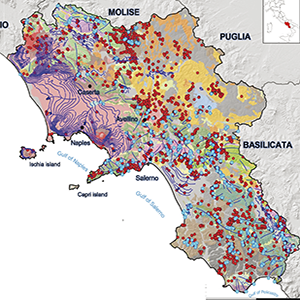The survey of Italian springs by the National Hydrographic Service, a forgotten database. Structuring and analysis of a dataset of Campania springs (southern Italy)

All claims expressed in this article are solely those of the authors and do not necessarily represent those of their affiliated organizations, or those of the publisher, the editors and the reviewers. Any product that may be evaluated in this article or claim that may be made by its manufacturer is not guaranteed or endorsed by the publisher.
Authors
The analysis of groundwater resources is a particularly significant aspect of the economic, social and environmental development of the national territory. This is particularly relevant for the Campania region which, although characterized by the most significant aquifer systems of southern Italy, suffers from critical issues related to the progressive increase in demand and climatic variability at different time scales. In this framework, the lack of data concerning the survey of springs, including the minor ones, and of historical discharge measurements represents the main limitation to a more comprehensive regional hydrogeological characterization. The only source of historical data regarding the systematic and comprehensive survey of springs and discharge measurement is the Publication No. 14 of the National Hydrographic Service of the Ministry of Public Works “The Italian springs. List and description” reporting measures made between the 1920s and 1940s which was published in distinct volumes for each compartment. Despite its potential relevance, this source has so far been little used in regional hydrogeological studies. In this paper, a comparative analysis among data of springs derived from the Publication No. 14 and from measurement campaigns made by the Cassa per il Mezzogiorno (Special Project 26), between the 1960s and 1980s for main springs, was carried out for the Campania region. The information available from each source was validated through a cross-check, by means of a comparison of coordinates and a statistical analysis of the characterizing parameters. The new dataset allowed to expand the hydrogeological regional characterization with a higher number of springs, including the minor ones. The results obtained recognize the Publication No. 14 of the National Hydrographic Service as an important source of data to not be overlooked, especially in a condition of historical data shortage, by which can be both carried out regional hydrogeological and temporal analyses as well as identified integrative groundwater resources.
How to Cite

This work is licensed under a Creative Commons Attribution-NonCommercial 4.0 International License.
PAGEPress has chosen to apply the Creative Commons Attribution NonCommercial 4.0 International License (CC BY-NC 4.0) to all manuscripts to be published.














